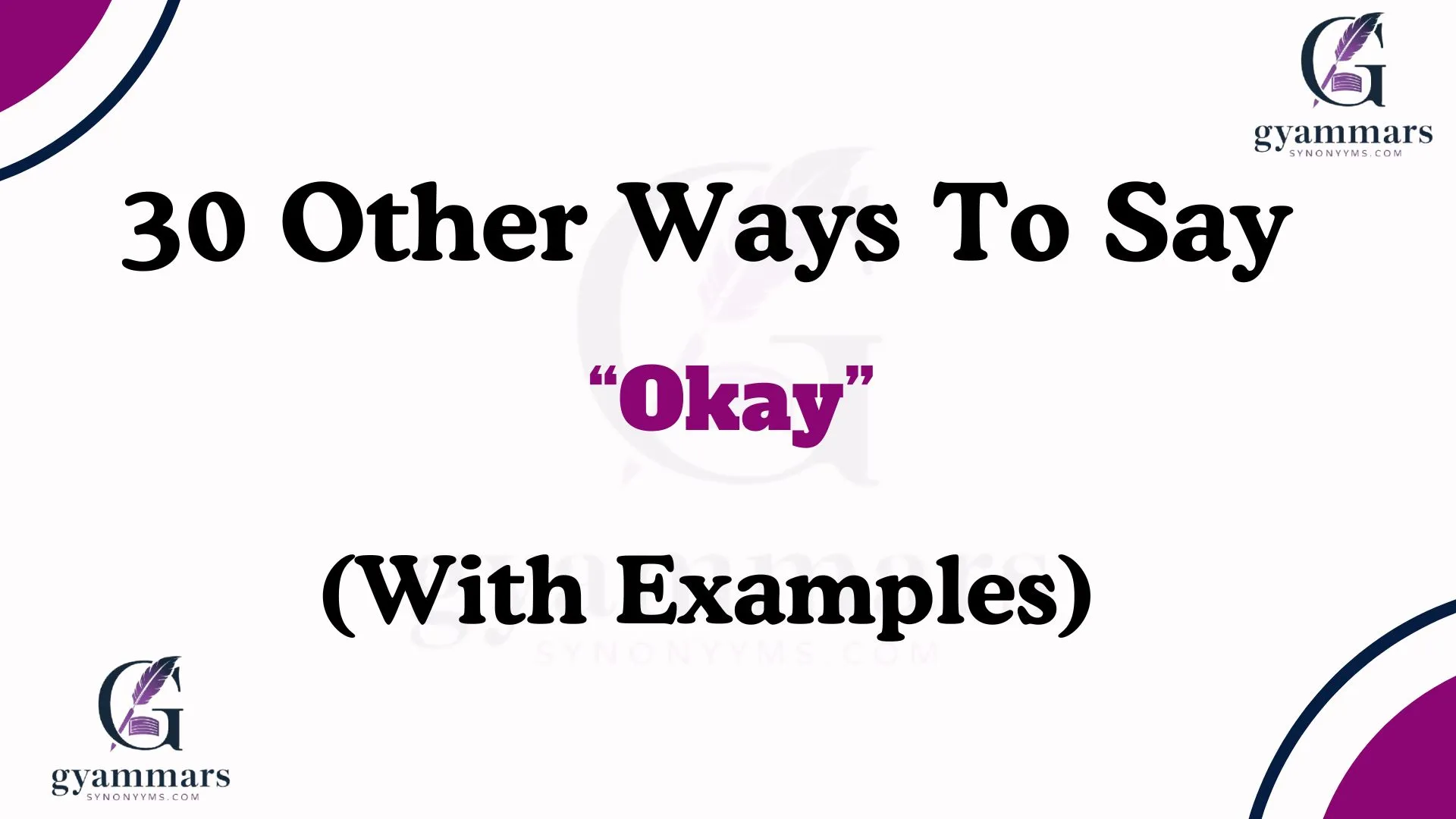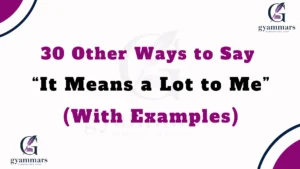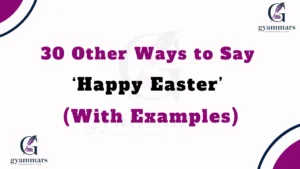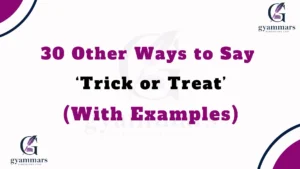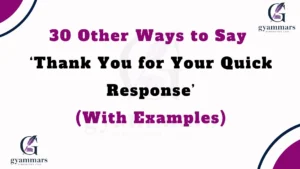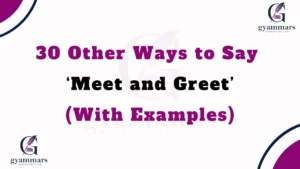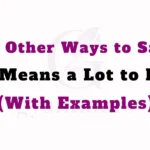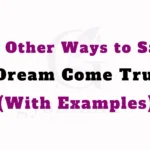Finding the right words to express yourself can make all the difference in how you communicate, especially when you’re aiming to sound warm, thoughtful, and considerate. Sometimes, a simple “okay” might feel too neutral or distant.
By switching it up and using different expressions, you can convey care, understanding, and engagement. Below, we’ve curated 30 meaningful alternatives to say “okay,” along with examples and tips on when and how to use them. These phrases can help you craft your messages with more personality, sincerity, and connection.
What Does “Okay” Mean?
Before diving into the alternatives, let’s break down what “okay” typically means in communication. It’s a word often used to express agreement, acknowledgment, or acceptance. While versatile, it can come across as somewhat neutral or detached. Depending on the tone and context, it may be appropriate for casual conversations but might fall short in more personal or thoughtful exchanges. Hence, finding more specific alternatives can add depth to your messages.
Is It Professional/Polite to Say “Okay”?
While “okay” is generally acceptable in both professional and casual contexts, its tone may come off as too blunt or disengaged in certain scenarios. In professional communication, it’s often better to use more polished alternatives, especially when conveying important messages or showing respect. While “okay” works well in informal chats, using a more refined or thoughtful response shows attentiveness and professionalism.
Pros and Cons of Saying “Okay”
Pros:
- Quick and easy to use.
- Universally understood.
- Neutral and non-committal, making it versatile.
Cons:
- Can sound flat or disengaged.
- May be seen as unenthusiastic or indifferent in certain situations.
- Less personal or warm compared to other alternatives.
Synonyms For “Okay”
- Sounds Good
- Sure
- Alright
- Got it
- Of Course
- No Problem
- I’m Good with That
- Absolutely
- I Agree
- Fine by Me
- Perfect
- That Works
- I’m On Board
- I’m In
- You Bet
- I’m Down
- All Set
- Consider It Done
- Sounds Like a Plan
- I’m Cool With That
- Roger That
- No Worries
- You Got It
- It’s a Deal
- I’m Game
- Okay, Cool
- Definitely
- Sure Thing
- You Got My Vote
- I’m All In
1. Sounds Good
Definition: An affirmative response that conveys a sense of approval or agreement.
Explanation: “Sounds good” is a friendly and upbeat way to show that you’re on board with something. It feels more casual and engaging than just saying “okay.”
Scenario Example:
Person 1: “I’ll meet you at 3 PM for coffee.”
Person 2: “Sounds good!”
Best Use: Casual conversations, informal professional settings.
Tone: Friendly, positive.
Additional Notes: Great for when you want to show enthusiasm without overcommitting.
2. Sure
Definition: A simple and clear way of agreeing or confirming something.
Explanation: “Sure” can be used in both casual and professional contexts. It shows readiness to agree or accept, but might come across as neutral in tone.
Scenario Example:
Person 1: “Do you want to go for a walk later?”
Person 2: “Sure!”
Best Use: Casual or semi-professional scenarios.
Tone: Neutral, polite.
Additional Notes: Great when you’re agreeing but not overly enthusiastic.
3. Alright
Definition: A casual way of saying “okay” that implies agreement and sometimes readiness.
Explanation: “Alright” has a friendly, approachable tone and works in both casual and semi-professional settings. It’s less formal than “okay” but conveys a comfortable vibe.
Scenario Example:
Person 1: “I’ll pick you up at 7.”
Person 2: “Alright!”
Best Use: Informal conversations, showing casual acceptance.
Tone: Relaxed, easygoing.
Additional Notes: Slightly warmer than “okay,” but still informal.
4. Got it
Definition: A phrase used to confirm understanding or agreement.
Explanation: “Got it” communicates that you’ve understood or are on board with something. It works well in situations where comprehension is important.
Scenario Example:
Person 1: “Please send me the report by 5.”
Person 2: “Got it!”
Best Use: In response to instructions or when confirming understanding.
Tone: Assertive, confident.
Additional Notes: Shows attentiveness and clarity.
5. Of Course
Definition: A response that implies an enthusiastic or obvious agreement.
Explanation: “Of course” conveys a high level of affirmation, suggesting that the request or statement is expected or easy to agree with.
Scenario Example:
Person 1: “Can you help me with this task?”
Person 2: “Of course!”
Best Use: When you want to show eagerness and willingness.
Tone: Warm, enthusiastic.
Additional Notes: Conveys a sense of assurance and friendliness.
6. No Problem
Definition: A phrase that indicates ease in agreeing to something.
Explanation: “No problem” is a reassuring way to say “okay,” suggesting that the request or task is easy and won’t be an issue.
Scenario Example:
Person 1: “Can you email me the file?”
Person 2: “No problem!”
Best Use: When you want to express a sense of ease and help.
Tone: Relaxed, helpful.
Additional Notes: Often used to show a willingness to assist.
7. I’m Good with That
Definition: A casual and positive way to agree.
Explanation: This phrase shows a higher level of comfort and satisfaction with a decision or plan. It’s slightly more personal than just saying “okay.”
Scenario Example:
Person 1: “How about we meet tomorrow instead?”
Person 2: “I’m good with that.”
Best Use: Informal conversations where you want to show ease.
Tone: Relaxed, comfortable.
Additional Notes: Great for casual situations or when you want to sound more relaxed.
8. Absolutely
Definition: An emphatic, strong agreement or confirmation.
Explanation: “Absolutely” shows a higher level of enthusiasm and certainty than “okay.” It works well in both casual and professional settings when you want to sound more committed.
Scenario Example:
Person 1: “Are you on board with the project?”
Person 2: “Absolutely!”
Best Use: When you want to express eagerness or strong agreement.
Tone: Enthusiastic, confident.
Additional Notes: Best for showing full agreement without hesitation.
9. I Agree
Definition: A formal way of expressing agreement.
Explanation: “I agree” is more formal and clear than “okay” and is often used in professional settings or serious discussions.
Scenario Example:
Person 1: “We should push the deadline to next week.”
Person 2: “I agree.”
Best Use: Professional or serious conversations.
Tone: Formal, thoughtful.
Additional Notes: Shows that you’re fully on board with a proposal.
10. Fine by Me
Definition: A casual phrase indicating that something is acceptable.
Explanation: “Fine by me” expresses that you’re happy with a plan or idea, though it can sound slightly more laid-back than other alternatives.
Scenario Example:
Person 1: “Should we start at 10 AM?”
Person 2: “Fine by me!”
Best Use: Informal situations where you want to show acceptance without formality.
Tone: Casual, laid-back.
Additional Notes: Best used in low-stakes, easy-going conversations.
11. Perfect
Definition: A response that suggests total satisfaction or approval.
Explanation: “Perfect” is often used to show full approval or agreement, implying that something is just right. It conveys enthusiasm and satisfaction.
Scenario Example:
Person 1: “We’ve confirmed the meeting time for 2 PM.”
Person 2: “Perfect!”
Best Use: Informal or semi-professional settings when everything aligns just right.
Tone: Positive, satisfied.
Additional Notes: Great when you want to show that everything is exactly as you expected or wanted.
12. That Works
Definition: A casual expression of agreement, meaning that a suggestion or plan is acceptable.
Explanation: “That works” is a flexible and neutral response that suggests the proposed plan or idea is agreeable and will proceed as suggested.
Scenario Example:
Person 1: “How about I pick you up at 6 PM?”
Person 2: “That works!”
Best Use: Casual conversations, especially when confirming plans or ideas.
Tone: Easygoing, agreeable.
Additional Notes: Useful when you want to confirm something without sounding too enthusiastic or formal.
13. I’m On Board
Definition: A phrase that indicates full support or agreement with a plan or idea.
Explanation: “I’m on board” shows a high level of commitment or support, often used in collaborative or team settings.
Scenario Example:
Person 1: “We should take the project in a new direction.”
Person 2: “I’m on board with that!”
Best Use: Professional settings or group discussions where you want to express full support.
Tone: Confident, supportive.
Additional Notes: Shows active participation and support for a plan.
14. I’m In
Definition: A friendly and enthusiastic way of showing agreement or participation.
Explanation: “I’m in” suggests eagerness to participate or engage with something. It’s often used in informal or social settings.
Scenario Example:
Person 1: “Want to join us for a road trip this weekend?”
Person 2: “I’m in!”
Best Use: Informal settings, social events, or casual invitations.
Tone: Enthusiastic, friendly.
Additional Notes: Great when you want to sound upbeat and excited to be involved.
15. You Bet
Definition: A phrase used to emphasize agreement, often with enthusiasm or assurance.
Explanation: “You bet” is a more casual and enthusiastic way of saying “yes” or “sure.” It suggests confidence and a positive attitude.
Scenario Example:
Person 1: “Can you help me with the project tomorrow?”
Person 2: “You bet!”
Best Use: Informal or friendly exchanges, when you want to express eagerness.
Tone: Enthusiastic, assured.
Additional Notes: Typically used in casual conversations and shows a high level of confidence in agreeing.
16. I’m Down
Definition: An informal way of expressing agreement or willingness to participate.
Explanation: “I’m down” indicates that you’re open to a suggestion or plan and are ready to participate. It’s casual and shows willingness.
Scenario Example:
Person 1: “Let’s go grab some dinner tonight.”
Person 2: “I’m down!”
Best Use: Casual conversations, especially among friends or peers.
Tone: Relaxed, willing.
Additional Notes: Best for informal settings and showing a laid-back attitude toward plans.
17. All Set
Definition: A phrase indicating readiness or preparedness.
Explanation: “All set” shows that you’re ready for something to happen and that everything is in place.
Scenario Example:
Person 1: “Are we ready to go?”
Person 2: “All set!”
Best Use: When confirming readiness or that everything is ready to proceed.
Tone: Positive, confirming.
Additional Notes: Useful when you’re ready to take action or begin a task.
18. Consider It Done
Definition: A confident statement implying that a task or request will be completed without hesitation.
Explanation: “Consider it done” conveys assurance and suggests that the task at hand will be completed, often with enthusiasm and commitment.
Scenario Example:
Person 1: “Could you send me the report by the end of the day?”
Person 2: “Consider it done!”
Best Use: Professional or assertive situations where you want to show commitment.
Tone: Confident, reassuring.
Additional Notes: Implies strong commitment to completing a task quickly.
19. Sounds Like a Plan
Definition: A response that shows agreement with a proposed idea or plan.
Explanation: “Sounds like a plan” suggests that the idea or suggestion works well for you and that you’re happy to move forward.
Scenario Example:
Person 1: “Let’s meet at the coffee shop at noon tomorrow.”
Person 2: “Sounds like a plan!”
Best Use: Casual conversations or when finalizing plans.
Tone: Friendly, agreeable.
Additional Notes: Conveys positive affirmation of a plan without being too formal.
20. I’m Cool With That
Definition: An informal way of saying that you’re okay with a suggestion or plan.
Explanation: “I’m cool with that” is a relaxed, laid-back way of agreeing with something. It’s typically used in casual, friendly conversations.
Scenario Example:
Person 1: “How about we head out around 8 PM?”
Person 2: “I’m cool with that.”
Best Use: Informal settings, especially when you want to show ease and comfort with the plan.
Tone: Laid-back, casual.
Additional Notes: Works well when you don’t need to show strong enthusiasm but still want to express agreement.
21. Roger That
Definition: A military-inspired phrase used to confirm receipt and understanding of a message.
Explanation: “Roger that” is often used in situations where confirmation is needed, indicating that the speaker has understood the information and is acknowledging it. It carries a tone of clarity and assurance.
Scenario Example:
Person 1: “Make sure to send the report by 5 PM.”
Person 2: “Roger that.”
Best Use: Situations where clear confirmation or acknowledgment is required, especially in professional or urgent contexts.
Tone: Confident, assertive.
Additional Notes: Common in military or high-stakes environments but is now used informally as well.
22. No Worries
Definition: A phrase used to indicate that something is not a problem or cause for concern.
Explanation: “No worries” is a reassuring way of saying that everything is fine or that the request is not an inconvenience.
Scenario Example:
Person 1: “Sorry for the delay, I’ll send it soon.”
Person 2: “No worries, take your time.”
Best Use: Casual, comforting settings where you want to ease someone’s stress or assure them.
Tone: Relaxed, reassuring.
Additional Notes: Great for informal exchanges, especially when you want to express that something is not an issue.
23. You Got It
Definition: An enthusiastic way to confirm something, showing that you’re ready and willing to do it.
Explanation: “You got it” is a confident, energetic response to show that you’ll take care of whatever is being asked or that you understand the request.
Scenario Example:
Person 1: “Can you make sure to pick up the groceries?”
Person 2: “You got it!”
Best Use: Casual settings, especially when you want to show eagerness to help.
Tone: Enthusiastic, willing.
Additional Notes: Works well in friendly exchanges where you want to show a positive attitude toward helping out.
24. It’s a Deal
Definition: A statement used to confirm an agreement or commitment.
Explanation: “It’s a deal” indicates that both parties are in agreement with the proposed terms or plan. It’s often used after a negotiation or decision has been made.
Scenario Example:
Person 1: “We’ll meet at 7 PM at the restaurant.”
Person 2: “It’s a deal!”
Best Use: When finalizing an agreement or confirming plans, often in negotiations or business discussions.
Tone: Assertive, satisfied.
Additional Notes: Used in both informal and formal contexts to finalize a decision.
25. I’m Game
Definition: A phrase used to indicate that you’re willing to participate in or agree to something.
Explanation: “I’m game” shows enthusiasm and readiness to be involved in a plan or idea. It’s often used in casual situations and conveys eagerness.
Scenario Example:
Person 1: “Do you want to go hiking this weekend?”
Person 2: “I’m game!”
Best Use: Informal settings, especially when discussing plans or activities.
Tone: Enthusiastic, ready.
Additional Notes: Great for showing that you’re excited and open to an idea or plan.
26. Okay, Cool
Definition: A casual way to agree or show approval.
Explanation: “Okay, cool” is a laid-back response that suggests approval or satisfaction with a plan or statement. It is often used in informal conversations.
Scenario Example:
Person 1: “Let’s meet at 8 PM tonight.”
Person 2: “Okay, cool!”
Best Use: Informal conversations or when confirming plans without much enthusiasm.
Tone: Casual, easygoing.
Additional Notes: Great for relaxed situations where you want to show agreement without being too formal or overly enthusiastic.
27. Definitely
Definition: A strong affirmation indicating total agreement or certainty.
Explanation: “Definitely” is used when you want to show absolute certainty or eagerness to proceed. It indicates strong commitment and enthusiasm.
Scenario Example:
Person 1: “Are you coming to the party tonight?”
Person 2: “Definitely!”
Best Use: Situations where you want to show strong commitment or excitement.
Tone: Enthusiastic, positive.
Additional Notes: A great option for when you want to sound very sure about something.
28. Sure Thing
Definition: An informal expression that shows agreement or confirmation.
Explanation: “Sure thing” is a relaxed, friendly way of saying “yes,” often used when agreeing to do something. It conveys willingness and ease.
Scenario Example:
Person 1: “Can you grab the tickets for the concert?”
Person 2: “Sure thing!”
Best Use: Informal settings, often used among friends or in casual business exchanges.
Tone: Friendly, easygoing.
Additional Notes: Light and informal, best used in situations where you want to sound laid-back.
29. You Got My Vote
Definition: A phrase indicating strong support or agreement, often used in decisions or choices.
Explanation: “You got my vote” shows that you agree with or support an idea or decision. It conveys enthusiasm and certainty in your choice.
Scenario Example:
Person 1: “I think we should choose this location for the event.”
Person 2: “You got my vote!”
Best Use: When expressing support for a decision, idea, or plan, especially in group settings.
Tone: Supportive, positive.
Additional Notes: Implies you are fully backing a choice, often used in group decisions.
30. I’m All In
Definition: A phrase expressing total commitment or participation in something.
Explanation: “I’m all in” signifies full commitment and eagerness to engage in a plan or idea. It shows that you are ready to give your full effort.
Scenario Example:
Person 1: “Let’s work together on this big project!”
Person 2: “I’m all in!”
Best Use: When you want to show complete dedication or involvement, often in professional or team-oriented situations.
Tone: Confident, dedicated.
Additional Notes: Best used in scenarios where you want to show serious commitment to a cause or project.
Conclusion
Using alternative expressions instead of simply saying “okay” can add more depth and warmth to your communication. Whether you’re conveying enthusiasm, agreement, or support, each of these alternatives serves a unique purpose and can help foster more meaningful interactions.
By choosing the right phrase for the situation, you show that you care about the conversation and the people involved. So next time you’re about to say “okay,” think about how you can say it with more intention and empathy!
FAQs
1. What does “Okay” mean?
Answer: “Okay” is a term used to express agreement, acknowledgment, or understanding. It is one of the most common ways to respond affirmatively in everyday conversations. It conveys that the speaker has accepted or understood the situation, request, or statement.
2. Is it professional/polite to say “Okay”?
Answer: Yes, “okay” can be professional and polite depending on the context. In casual or informal conversations, it is widely accepted. However, in formal settings, you may want to use alternatives like “Certainly,” “Understood,” or “I agree” to convey a more polished tone.
3. Why should I use alternatives to “Okay”?
Answer: Using alternatives to “okay” can help you express yourself more thoughtfully, adding warmth, enthusiasm, or clarity to your conversations. It can also make you sound more engaged and considerate, whether in professional or personal interactions.
4. Which alternative to “Okay” is best for a casual conversation?
Answer: Phrases like “No problem,” “Sounds good,” or “Sure” work well in casual, friendly exchanges. These options feel relaxed and approachable, making them perfect for informal settings.
5. Are there any alternatives to “Okay” that convey more enthusiasm?
Answer: Absolutely! If you want to show excitement, use alternatives like “You got it,” “Definitely,” or “I’m all in.” These phrases are energetic and demonstrate a positive attitude.

“Emma Rose at Grammar Synonyms is your go-to expert for everything related to language and expression. Whether you’re refining your grammar, searching for the perfect synonym, or looking for creative ways to improve your writing, Emma Rose provides the tools and inspiration you need. With a wide range of resources designed to elevate your communication, Grammar Synonyms helps you find just the right words to make every sentence shine.
